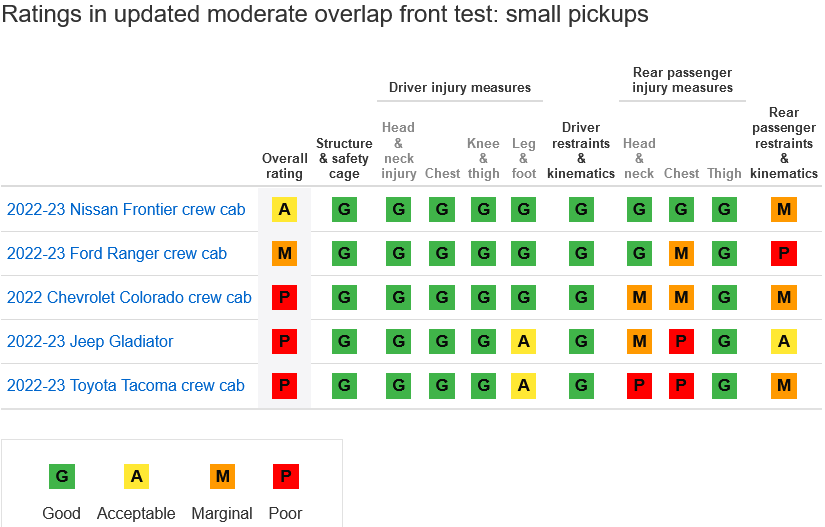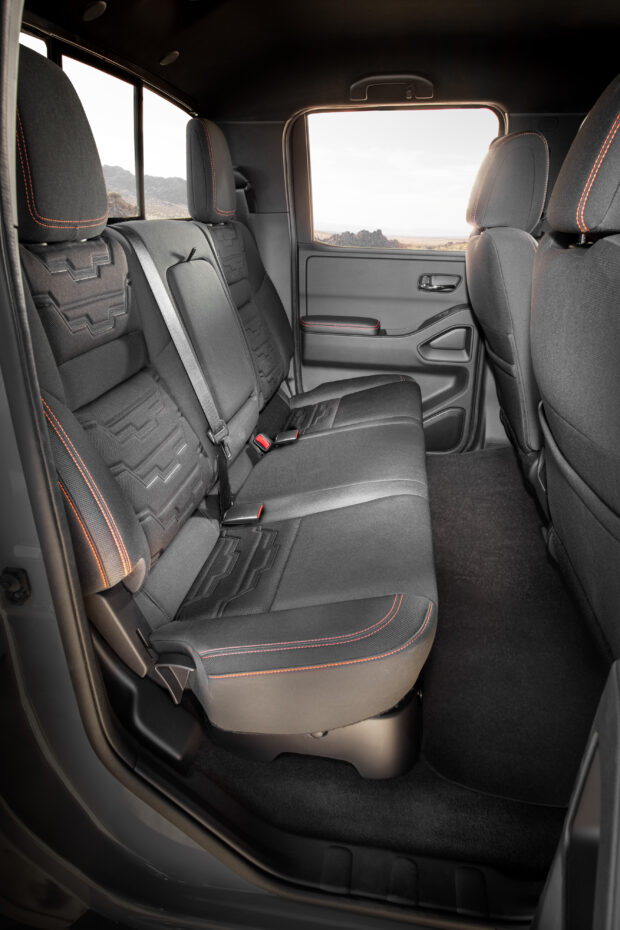The latest crash tests by the Insurance Institute for Highway Safety reveals most small pickups fall short when it comes to rear seated passengers.
“Our updated moderate overlap front crash test proved to be challenging for small pickups,” said IIHS President David Harkey. “A common problem was that the rear passenger dummy’s head came dangerously close to the front seatback, and in many cases, dummy measurements indicated a risk of neck or chest injuries. All these things tell us that the rear seatbelts need improvement.”
None of the five small crew cab pickups IIHS tested earned a good rating. The Nissan Frontier received an acceptable rating. The Ford Ranger earns a marginal rating, and the Chevrolet Colorado, Jeep Gladiator and Toyota Tacoma were all rated poor.
The ratings only apply to the crew cab versions.

The moderate overlap front test was updated last year after research revealed the risk of a fatal injury is now higher for belted occupants in the rear than for those in front in newer vehicles.
Safety improvements in the front seat now highlight deficiencies in the rear seat, the safety watchdog stated.
The front seat has become safer because of improved airbags and advanced seatbelts, rarely available in back.
The back seat still remains the safest place for young children, IIHS noted, since they can be injured by an inflating front airbag.
To encourage manufacturers to improve rear seat protection, the updated test adds a dummy in the back seat located behind the driver. The driver dummy is the size of an average adult man. The rear dummy is the size of a small woman or 12-year-old child.
IIHS researchers also developed new metrics that focus on the injuries most frequently seen in back seat passengers.
For a vehicle to earn a good rating, there can’t be an excessive risk of injury to the head, neck, chest or thigh, as recorded by the second-row dummy, the IIHS outlined.
The dummy should remain correctly positioned during the crash without sliding forward beneath the lap belt (or “submarining”).
The head should also remain a safe distance from the front seatback and the rest of the vehicle interior.
A pressure sensor on the rear dummy’s torso is used to check whether the shoulder belt is too high, which can make the restraint system less effective.
As in the original test, the structure of the occupant compartment must maintain adequate survival space for the driver, and measurements taken from the driver dummy shouldn’t show an excessive risk of injuries, the crash safety organization noted.
All five small pickups provided good protection in the front seat. However, analysis of measurements taken indicated a slightly higher risk of leg or foot injuries to the driver in the Gladiator and Tacoma.
In the Colorado, Frontier, Ranger and Tacoma, the restraints in the back seat allowed the rear dummy’s head to come too close to the front seatback. That was not an issue for the Gladiator. However, its rear restraints do not include a side curtain airbag, increasing the risk of injury from a hard impact with the interior of the vehicle or even something outside it.
In the Ranger, the rear dummy submarined beneath the lap belt, IIHS said, causing it to ride up from the ideal position on the pelvis onto the abdomen, increasing the potential for internal injuries.
Otherwise, injury measures taken from the rear dummy indicated a moderate or likely risk of both neck and chest injuries in the poor-rated Colorado, Gladiator and Tacoma and a moderate risk of chest injuries in the marginal-rated Ranger.





















 Unpacking a Consumer Intervenor’s Novel Idea
Unpacking a Consumer Intervenor’s Novel Idea  Artificial Intelligence Is Rewriting the Rules for Commercial Lines
Artificial Intelligence Is Rewriting the Rules for Commercial Lines  How Carriers Are Pairing AI and Process Discipline to Drive Subrogation Outcomes
How Carriers Are Pairing AI and Process Discipline to Drive Subrogation Outcomes  The Future of Knowledge in Insurance: From Training to AI-Powered Productivity
The Future of Knowledge in Insurance: From Training to AI-Powered Productivity 



